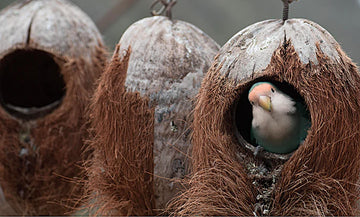Why don’t birds have teeth? 13 AMAZING Facts About Teeth in the Animal Kingdom
Jul 07, 2020

Did you know that birds don’t have teeth?
Alright, that one might be pretty obvious…but do you know why birds don’t have teeth?
Think about it. Many of the dinosaurs, birds’ next of kin, had teeth…so what happened in the evolutionary chain to make birds evolve without them?
Today, we thought we’d give you a fun educational break by bringing you 13 incredible “toothy” facts from the animal kingdom that the whole family will love!
#1 So…why don’t birds have teeth?
Well, once upon a time, they did! One of the oldest birds, the Archaeopteryx from the Jurassic period, actually had reptilian-like teeth! Then, starting in the early Cretaceous period, birds lost their teeth.
So, what happened? It’s hypothesized that some theropod dinosaurs (the clade which birds evolved from) actually lost their teeth and formed small beaks at the end of their lifetime.
This trend of losing teeth and sprouting a beak in adulthood is not actually unique to dinosaurs. It’s also been seen in fish, amphibians, pangolins and even certain whales. The gene responsible for tooth suppression in birds is also responsible for beak growth, indicating that there is a genetic link between the development of a beak and the loss of teeth.
Throughout evolution, this beak developed earlier and earlier until eventually birds hatched with a beak already fully formed.
#2 All that said, there is actually one.
South America bird called the Hoatzin that does have a tooth. Hoatzin chicks use a small tooth to help them escape from the egg, and then immediately shed it post-hatch.
#3 Which animal has THE MOST teeth? Go on. Guess. We’ll wait.
The snail!!! Your (literally) garden variety snail has 14,000 teeth! Some snails can even have up to 25,000 teeth. Where do they keep these teeth? On their tongue! Not only that, snail teeth can be incredibly strong.
In fact, the teeth of an aquatic snail are actually the hardest biological substance on the planet, beating out spider silk which was, until recently, thought to be the most durable.
#4 Why are sharks so cranky?
They’re constantly losing their teeth! In fact, they lose about one tooth per week. Sharks have their teeth in rows and, when one falls out, the one behind moves up to replace it. Their teeth grow this way throughout their entire life.

#5 Narwhal horns are actually teeth!
What?! That’s right. The unicorn of the sea actually has a large tooth growing out of its face. This tooth is unlike any other mammalian tooth too.
It is essentially “inside-out”, meaning that it has a soft outside and gradually gets harder and more durable toward the middle of the tooth. The narwhal uses this soft, nerve-laden tissue on the outside to sense changes in the salinity of the water.
One more thing: despite being part of the group of “toothed whales”, the narwhal does not actually have any teeth growing in its mouth.
#6 Wonder why animals don’t have dentists in the wild?
No, it’s not only the lack of medical education, it’s also because, in the wild, animals typically have a much lower incidence of cavities because of the low proportion of sugar in most wild animal diets. Since we tend to supply animals in captivity with more sugar than can be found in the wild, they tend to develop more cavities.
#7 Rodents, rabbits, and hares have incisors that grow throughout their entire lives.
In fact, the teeth of the pocket gopher can grow up to 15 inches a year! So why didn’t your guinea pig “Mr. Bob” have 12 foot long nightmare fangs like some abomination from an R.L. Stine novel? Their teeth wear down from continual use over time. In fact, the name “rodent” is actually derived from the Latin word “to gnaw”.
#8 Hippos have the longest canines of any living animal.
At a whopping 3 feet long, it’s pretty intimidating! Not sure we want that hippopotamus for Christmas anymore…
#9 Like trees, animals have rings on their teeth known as perikymata.
These rings can be used to determine the rate of tooth development, and even age in animals such as dolphins where enamel wear is minimal. Perikymata are also found on humans, where a ‘ring’ forms every 6-12 days.
Basically, you have hundreds, if not thousands, of lines on your teeth! Not only that but, in paleontology, the proximity of perikymata to each other and the thickness of each ring can be used to assess growth rate and certain environmental stressors.
#10 Horses can have receding gums!
In fact, this is where the phrase “long in the tooth” comes from. The receding gums make it appear like the horse tooth is growing longer! That said, horses do actually start out with long teeth. Why? Horses eat grass, which contains small glass shards called “phytoliths” that, as you can imagine, file down the tooth over time. They need longer teeth for a lifetime of munching on hay.

#11 How do you tell the difference between frogs and toads?
Frogs have teeth, but toads don’t! Why is that? Both frogs and toads swallow their prey whole, but it’s thought that the frogs use the teeth as a way to get a grip on their victim prior to consumption. Since frogs are mostly aquatic and toads are mostly terrestrial, frogs might need the extra advantage to hold onto slippery prey!
#12 Here’s a fact to “bug” you out.
Did you know that certain insects have teeth? These insects are the “chewing” insects like grasshoppers, beetles, crickets, termites and cockroaches. Interestingly, their teeth don’t work up and down like most animals, but side to side to “shred” their prey.
#13 One elephant molar can weigh as much as 9 pounds.
In other words, you could have an elephant tooth that weighs more than a newborn baby. Another cool elephant fact? Their tusks are actually teeth as well!
We hope these fun dental animal facts gave you a reason to show off your own pearly whites today!


